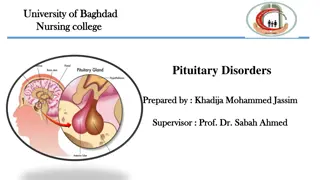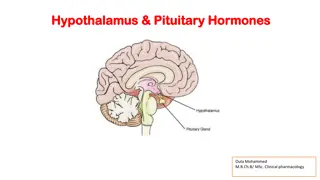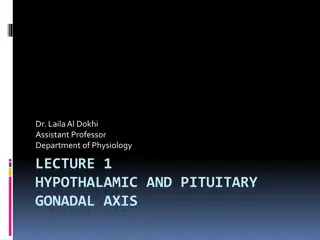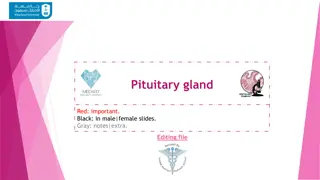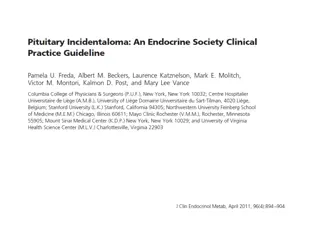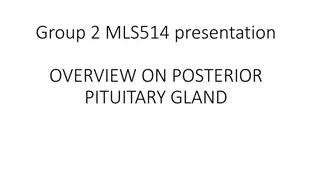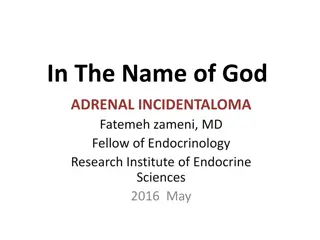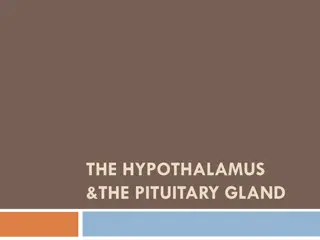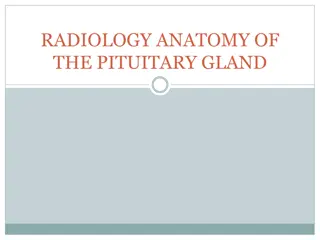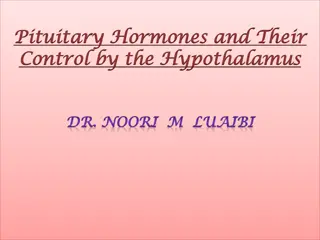Pituitary Incidentaloma - Definition and Controversies
The Endocrine Society guidelines define a pituitary incidentaloma as an unsuspected pituitary lesion found incidentally on imaging not related to symptoms like visual impairment. However, there is controversy over whether predominantly cystic tumors should be included, as they may present differently. Understanding this definition is crucial for appropriate management and treatment strategies.
Download Presentation

Please find below an Image/Link to download the presentation.
The content on the website is provided AS IS for your information and personal use only. It may not be sold, licensed, or shared on other websites without obtaining consent from the author.If you encounter any issues during the download, it is possible that the publisher has removed the file from their server.
You are allowed to download the files provided on this website for personal or commercial use, subject to the condition that they are used lawfully. All files are the property of their respective owners.
The content on the website is provided AS IS for your information and personal use only. It may not be sold, licensed, or shared on other websites without obtaining consent from the author.
E N D
Presentation Transcript
In the name of allah The compssionate the merciful
Current Practice in Neurosciences 2020 Up to date 2020 Endocrinology advisor 2020 Elsevier 2019 Neuroradiology review series 2016 Williams textbook 2020 Endocrine society guideline 2011
The Endocrine Society practice guidelines, published in 2011, defined a pituitary incidentaloma(PI) as a previously unsuspected pituitary lesion that is discovered on an imaging study performed for an unrelated reason
This definition, implies that the imaging study was not done for a symptom specific to the lesion, such as visual impairment, or abnormal pituitary function.
There is some controversy regarding this definition; some authors are reluctant to include predominantly cystic tumors as pituitary incidentalomas , since the differential diagnosis for these tumors may be expanded to include other lesions..
Although the Endocrine Society Practice guidelines include cystic tumors in their definition of pituitary incidentalomas, these lesions should be approached cautiously, as their biological behaviour and treatment strategy differ.
include evaluation of headache, giddiness, strokes, head trauma or as part of CNS screening for other systemic disorders.
for imaging in the case series was headache, which relates one of the controversial topics regarding the association between headaches and pituitary incidentalomas: considering the fact that headache may be one of the symptoms of pituitary tumors and that in some patients the headache resolves following removal of the tumor, would it be correct to classify these tumors as incidental?
It is complex and is most definitely multifactorial. Putative mechanisms include : stretching of the diaphragm sella, elevation of intrasellar pressure, invasion of the cavernous sinus, hormonal hypersecretion (particularly in patients with growth hormone-secreting tumors)
on the basis of size, these lesions may be further sub-classified as microincidentalomas (<1 cm) macroincidentalomas ( 1 cm).
Common factors favouring non-pituitary sellar pathology include calcifications (seen in craniopharyngiomas) or a small sella, cholesterol crystals with lack of cyst wall enhancement (seen in Rathke s cleft cysts)
Some authors have indeed provided retrospective evidence testifying to the efficacy of transsphenoidal surgery in alleviating headache in patients with sellar masses. Nevertheless, the decision to operate on a non-functional pituitary tumor for relief of headache alone remains extremely controversial
Among adults undergoing imaging studies (computed tomography [CT] or magnetic resonance imaging[MRI]) for reasons other than pituitary symptoms or disease, the frequency of incidentally discovered signal abnormalities (<10 mm) varies among studies from 4 to 20 percent by CTand 10 to 38 percent by MR
In some studies, only lesions that fulfill imaging criteria for a pituitary adenoma are considered as PIs, while in other series there is no such distinction, and even technical artifacts or physiological pituitary enlargement are included in the definition. Differences in the definition of PIs and the type of technique employed in imaging studies are the main factors affecting their prevalence.
A significant proportion of the asymptomatic general population may harbour occult pituitary adenomas, as suggested by autopsy studies estimating a 1.5-27% the frequencies were similar for men and women and across age groups in adults
Although incidentally detected pituitary tumors account for a very small proportion of patients undergoing transsphenoidal surgery for pituitary disease, this subset of patients with pituitary disease merit special attention to prevent (1) unnecessary surgical resection and its associated morbidity (2) unchecked disease progression to a stage where visual and hormonal dysfunction may be irreversible.
A dreaded complication of expectant management in patients with pituitary incidentalomas is the occurrence of apoplexy, often leading to permanent visual deterioration and hypopituitarism.
In a study by Arita et al almost 10% of patients with incidentally detected non-functional pituitary tumors developed spontaneous intra-tumoral hemorrhage over a mean follow-up period of five years, suggesting that early surgery might be a good option in young patients with tumors larger than 15 mm in maximum dimension..
authors also recommended avoiding prescribing drugs like bromocriptine or anticoagulants, which are infrequently associated with precipitating apoplexy in these patients
Not all incidentally discovered sellar masses are pituitary adenomas. However, pituitary adenomas are a common finding
pituitary adenomas are the most common cause of PIs, accounting for70-80% of the cases in neuroradiological and surgical cohorts, followed by Rathke's cleft cysts and craniopharyngiomas-
The commonest non-pituitary sellar incidentalomas include Rathke s cleft cysts and craniopharyngiomas, although the latter is almost never truly incidental. Rathke s cleft cysts are benign, epithelium lined cysts derived from Rathke s pouch, and are seen in up to a third of autopsy specimens
Most RCCs are detected incidentally, and serial observation with periodic MRIs is recommended for these lesions, as less than 5% of cases show any progression in size over long-term follow-up.
In a postmortem Japanese study, Rathke'scleft cysts were first in place and pituitary adenomas second, followed by a combination of nodular hy-perplasias, infarctions, hemorrhages, granular cell myoblastoma and lymphocyte infiltration
Some anatomic variations may also masquerade as pituitary lesions. Patients with an empty sella syndrome without prior surgery or radiation therapy may present with a cyst in the sella, which characteristically does not deviate the pituitary stalk. This condition is often associated with pseudotumor cerebri, particularly in young women with headache
An osseous sellar spine, protruding anteriorly from the dorsum sellae into the pituitary fossa may rarely be mistaken for a pituitary lesion.
Physiological enlargement of the pituitary gland may occasionally be confused with a pituitary adenoma. Hypertrophy of the pituitary gland is seen in adolescence and usually returns to normal adult proportions in the third decade of life.
physiological pituitary hyperplasia also occurs in children with central precocious puberty and menopause and secondary to lactotroph proliferation in pregnancy and the immediate post- partum period. In about 80% of patients with primary hypothyroidism, the pituitary gland may be enlarged on imaging; however, this almost always reverts with appropriate replacement therapy
Thyrotroph, gonadotroph, or rarely corticotroph hyperplasias occur in the presence of long-standing primary thyroid, gonadal, or adrenal failure, respectively.
Pituitary enlargement may also occur as a result of ectopic GH-releasing hormone (GHRH) or corticotrophin-releasing hormone (CRH) secretion, from pulmonary and pancreatic neuroendocrine tumors or hypothalamic gangliocytomas, with resultant hyperplasia of somatotroph or corticotroph cells
Radiological findings that are clues for PHinclude symmetrical pituitary enlargement,superior convexity, normal adeno and neurohypophysis signals and homogenous contrast enhancement
Noteworthy, these cases do not reflect pituitary lesions and should not be addressed with the same recommendations as for PI
Cavernous sinus invasion and hemorrhage in a macroadenoma.A, Sagittal noncontrast T1-weighted image shows a sellar/suprasellar mass with a hyperintense upper component due to hemorrhage.B,Postcontrast T1-weighted image shows enhancement of the lesion except for the hemorrhagic componen
Pituitary adenomas can be either functioning or nonfunctioning Although functional tumors can be associated with significant symptoms secondary to the hormone excess, cases of nonfunctional pituitary tumors may present with symptoms related to the mass effect on surrounding structures, such as headache, visual defects, and hypopituitarism.
Little information is available about the natural history of incidentally discovered sellar mass. the biological behavior of pituitary adenomas is varied and depends strongly on tumor histology.
most microincidentalomas (lesions <10 mm) have a benign course, whereas macroincidentalomas ( 10 mm) require more attention as the risk for hormone abnormalities and mass effects is higher
In addition to visual impairment, incidentalomas may also become symptomatic as a result of new-onset pituitary dysfunction, which can occur at a rate of 2.4% per year. Nevertheless, spontaneous regression of sellar masses may also be seen infrequently
The findings from both imaging and post- mortem studies indicate that an incidentally discovered pituitary microadenoma rarely transforms in to a pituitary macroadenoma
solid lesions and macroadenomas have a greater tendency for growth over the years than cystic lesions and microadenomas, with visual deterioration occurring almost exclusively in macroadenomas and pituitary apoplexy rarely seen in observational studies.
Local tumor aggressiveness appears to be multifactorial, and extrasellar growth patterns are often non-specific. Nevertheless, amonge non-functional tumors, certain histological subtypes are indeed known to behave aggressively, particularly the silent corticotroph adenomas, Crooke cell adenomas, silent somatotroph adenomas and Pit1-positive pluri hormonal adenomas
Attempts at characterising preoperative radiology in these patients are limited; however, more frequent cavernous sinus invasion, microcystic changes and intratumoral apoplexy has been described in silent corticotroph adenomas.
Interestingly, pituitary incidentalomas children have different patterns than those detected in the adulthood with a high prevalence of physiologic pituitary hypertrophy. incidentalomas in
As most incidentalomas in pediatric patients are not associated with hormonal hypersecretion or hypopiuitarism and structural progression is not common, it is believed that the extensive follow-up assessment recommended for adults might not be necessary for children
Management Issues in Pituitary IncidentalomasIs


